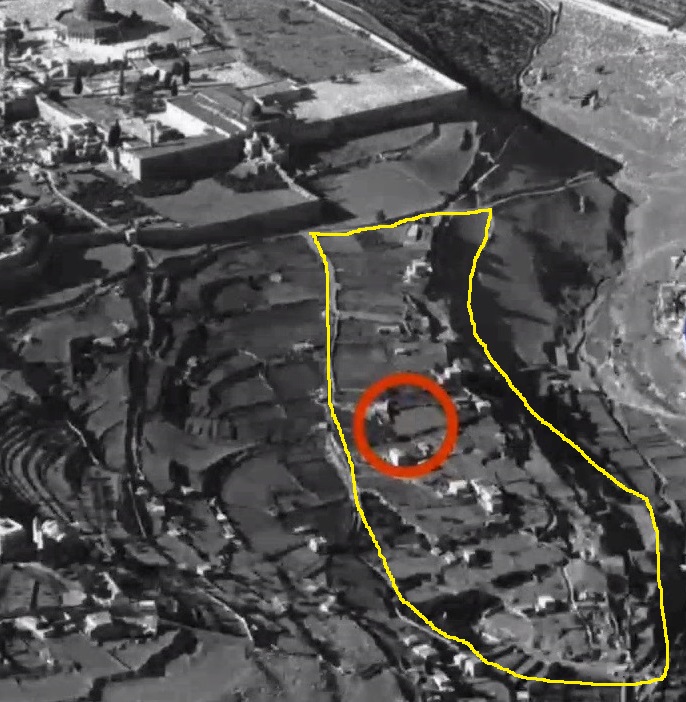
Courtesy of Bob Cornuke
The Original City of David
For Jews and Christians Scripture tells us, and history confirms, the location of the Temple of God. When reviewing the following information, please remember that Jerusalem (the City of David) at the time of David was the small peninsula-shaped piece of land south of the traditional Temple Mount. It was composed of about twelve acres. It was not the much expanded Jerusalem of today.
The photo below shows the “peninsula” of the City of David. The square area above it is what is known as the Temple Mount. I refer to this as the traditional Temple Mount because there are few, if any, facts identifying it as the location of the Temple of Solomon, Zerubbabel or Herod.

David’s men captured the fortified Jebusite stronghold. He lived there and called it the City of David. He developed the City of David by filling the areas between the walls and the hill and built upon it. (Second Samuel 5:9 )
The area created when the walls were built or expanded around Jerusalem was called the “Millo.” The term comes from the Hebrew word which means “to fill.” When the walls were built, dirt and rocks were used to fill the vacant space and to level the area. This was the Millo.
When King David sinned by taking a census of his fighting men, the Lord sent an angel:
“And God sent an angel unto Jerusalem to destroy it: . . . And the angel of the LORD stood by the threshing floor of Ornan the Jebusite. And David lifted up his eyes, and saw the angel of the LORD stand between the earth and the heaven, having a drawn sword in his hand stretched out over Jerusalem.” - First Chronicles 21:15-16
The angel of the Lord was standing over Jerusalem, the City of David. King David bought that property from Ornan for six hundred shekels of gold by weight. (First Chronicles 21:24-26) Later, Solomon built the House of the Lord at the place that David had prepared, in the threshing floor of Ornan the Jebusite. (Second Chronicles 3:1) Solomon built the Temple of God in the Jerusalem of his day, in what we know as the City of David.
Solomon also built the wall around the Jerusalem of his day. (First Kings 9:15) Flavius Josephus, the First Century Jewish historian, describes this place as the hill which Solomon encompassed with a wall. (Flavius Josephus, Antiquities of the Jews, Book XV, Chapter 11, Paragraph 3) Josephus continues; “This hill was walled all round, . . . in the midst of which was the Temple itself.” – ibid. Josephus clearly states that the Temple was in the center of this walled compound in the City of David.
More importantly, Holy Scripture tells us that the Temple was in the center of the City of David. Ezekiel chapters ten and eleven describe the Glory of the Lord departing the Temple about 600 B.C. After the Glory paused over the eastern threshold of the Temple (Ezekiel 10:19), it then “went up from the midst of the city, and stood upon the mountain which is on the east side of the city.” (11:23) The mountain to the east is probably the Mount of Olives. This is the point where the Lord will set foot when He returns. (Zechariah 14:4)
The traditional Temple Mount cannot be considered the center of the City of Jerusalem at the time of King Solomon. The area north of the traditional Temple Mount was not settled until the Second Temple period. This area is known as the Bezetha and is referred to by Josephus as the “New City.” It did not become part of Jerusalem until it was walled in by King Agrippa (41-44 A.D.), after the time of the Lord Jesus. When the Glory of the Lord rose up from the midst of the city, it was the City of David.
Josephus and historians before him recorded the fact that the Temple of God was in the center of the City of David, which is south of the traditional Temple Mount. The Jewish Mishnah contains an injunction against using the Temple as a short cut between the two parts of the city. It is difficult to imagine using the traditional Temple Mount as a shortcut.
Nehemiah chapter three tells of the rebuilding of the walls of Jerusalem after the Babylonian destruction. Verses 15 and 16 specifically mention geographic features (e.g. – the Pool of Siloam) that are only located in the City of David. Nehemiah 12:36-37 confirms that the Jerusalem of the time following the Babylonian Captivity was the City of David.
Scripture and the historian Flavius Josephus tell us that the Temple was in the City of David. However, two hundred years ago, the location of the City of David was not known with certainty. It had been lost. Then Hezekiah’s tunnel was found in 1838. This is the tunnel King Hezekiah had prepared in anticipation of an attack by the Assyrians. (Second Chronicles 32:30) The tunnel runs from the Gihon Spring to the Siloam Pool at the foot of the City of David. Today, archaeologists have found this tunnel beneath the City of David.
The Gihon Spring
Large amounts of water were required for Temple worship. There was much blood, from the many sacrifices, that needed to be washed away. Also, the great bronze Sea, which held 3,000 measures (baths) of water, required almost 18,000 gallons of water to be filled. The priests used this water to cleanse themselves before entering the Temple. This water was changed daily per Alfred Edersheim. (The Temple, Alfred Edersheim, p. 45)
Some explain the water as being provided by the Gibeonites, (Joshua 9:27) but this occurred during the time of the Tabernacle. Others believe the “Pools of Solomon,” about five miles from Jerusalem, were the source of water for the Temple via aqueduct. Archaeologists say that these pools were so named long after the time of Solomon (c. 960B.C.). According to archaeologists, the pools and aqueducts date to the Second Temple period (586 B.C.-70 A.D.), long after the Temple of Solomon. The Second Temple was built on the same site as Solomon’s Temple.
The Letter of Aristeas is of Greek origin and was written in the Third Century B.C. Josephus gave this letter great credibility. Aristeas described the Temple’s having “an inexhaustible supply of water, because an abundant spring gushes up from within the temple area.” (Letter of Aristeas to Philocrates, Pseudepigrapha of the Old Testament, Letter of Aristeas, R. H. Charles, Volume 2, page 83, verse 89)
The root of “Gihon” means to burst forth or gush. The Gihon Spring is a siphon spring, which means that it periodically gushes forth water. There is no natural source of water on or around the traditional Temple Mount. Can you imagine carrying 18,000 gallons of water up to the traditional Temple Mount from the Gihon Spring on a daily basis? This amounts to about seventy-five tons of water. That was not practical.
Although not speaking of the Temple, the Lord gives us an interesting comparison between the Gihon Spring as a water source and the cisterns found beneath the traditional Temple Mount.
“For my people have committed two evils; they have forsaken me the fountain of living waters, and hewed them out cisterns, broken cisterns, that can hold no water.” – Jeremiah 2:13
There are two immovable geographic features at Jerusalem; the Gihon Spring and the rock precipice described by Josephus as the location of the Roman fort (see below). These both give a strong indication as to the location of the Temple. The map below shows the City of David with an elevation of 2,263 feet, which is adjacent to the Gihon Spring. The precipice to the north of the spring with an elevation of 2,460 feet is labeled with an “X.” These are two totally different locations, separated by a distance of 1,582 feet, or over a quarter mile. I believe the Temple of God was in the City of David as indicated by Scripture, and these unchangeable geographic features.
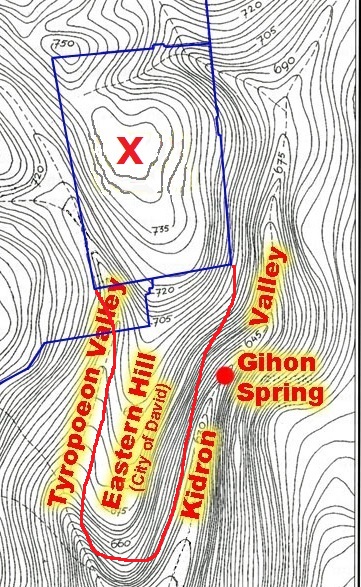
The Jebusites had built a city where there was a source of water, the Gihon Spring. David’s men captured the city, and renamed it the City of David. The City of David is located over the Gihon Spring. The Gihon Spring and Hezekiah’s Tunnel are in the City of David.
We know where the City of David is located. And, again, the Bible and history tell us that the Temple was located in the City of David. If the Temple was located in the City of David, what was the traditional Temple Mount? The Jewish historian Flavius Josephus tells us:
“Now on the north side [of the Temple] was built a citadel, whose walls were square, and strong, and of extraordinary firmness. This citadel was built by the kings of the Hasmonean race, who were also high priests before Herod, and they called it the Tower. But for the Tower itself, when Herod the king of the Jews had fortified it more firmly than before, in order to secure and guard the temple, he gratified Antonius, who was his friend, and the Roman ruler, and then gave it the name of the Tower of Antonia. Now as to the Tower of Antonia, . . . it was erected upon a rock of fifty cubits in height, and was on a great precipice;" - Flavius Josephus, Wars of the Jews, Book V, Chapter 5, Paragraph 8
In 73 A.D., after the destruction of the Temple by the Romans in 70 A.D., Eleazar, a Jewish leader, lamented to see “the foundations of our holy temple dug up after so profane a manner.” He also stated that Jerusalem was totally destroyed except “the camp of those that hath destroyed it, which still dwells upon (over) its ruins.” The Wars Of The Jews, Book VII, Chap. 8, Para. 7. (emphasis added)
All that remained after 70 A.D. was the Roman fort (the camp – the Tower of Antonia).
For centuries it has been assumed that the Temple of God was located on what has become known as the Temple Mount. However, Jesus said that “not one stone would be left on top of another.” (Matthew 24:2) Today, confirming the statement of Eleazar, there is no remaining structural evidence of the Temple of God. It was all leveled.
The Tower of Antonia
It appears that the traditional Temple Mount is actually a Roman fort. Roman forts were all large rectangular structures. They contained barracks for soldiers and administrative buildings. They all were several acres (30-36) in size. This, of course, describes the 36 acre traditional Temple Mount.
Josephus describes the interior of the Tower of Antonia:
“The inward parts had the largeness and form of a palace, it being parted into all kinds of rooms and other conveniences, such as courts, and places for bathing, and broad spaces for camps; insomuch that, by having all conveniences that cities wanted, it might seem to be composed of several cities, but by its magnificence it seemed a palace.” (Flavius Josephus, Wars of the Jews, Book V, Chapter 5, Paragraph 8) (my emphasis) This sounds like the traditional Temple Mount.
Josephus describes the Roman fort in Jerusalem as being north of the Temple, and housing a legion of men. (ibid.) A Roman legion had about 6,000 soldiers, plus administrators and support personnel. This could total as many as 10,000 men, and would need a fort the size of the traditional Temple Mount.
Israeli archaeologist Dr. Eli Shukron found a coin beneath the lowest course of foundation stones in the Western Wall of the traditional Temple Mount. The coin was dated 19-20 A.D. Renovations of Herod’s Temple were completed in 4 B.C., long before this date. The Western Wall is part of Herod’s expansion of the Tower of Antonia and is clearly part of the Roman fort.
Remember the two immovable geographic features at Jerusalem; the Gihon Spring and the rock precipice. Josephus wrote that the Tower of Antonia was built on a fifty cubit (seventy-five foot) high precipice. This describes the traditional Temple Mount. It is the only rock precipice in the area.
The Muslim Dome of the Rock is built over the high point of the seventy-five foot high precipice. This is the location where the native rock protrudes above the paving stones of the traditional Temple Mount. If the traditional Temple Mount was the Tower of Antonia, then this high point was probably the location of Pilate’s praetorium, where the Lord Jesus was brought before him. If this is so, the Dome of the Rock honors and protects the very place where the Lord of Glory was condemned. (First Corinthians 2:8)
The Tomb of King David
Currently, the Tomb of King David is said to be on the Western Hill of Jerusalem in a 1,000 year old building. But Scripture places the Tomb of David in the original boundaries of the City of David. Nehemiah chapter three describes the rebuilding of the walls of the City of David. As he records the repairs section by section, in verse fifteen he notes the Pool of Siloam and the steps leading down from the City of David, both of which are at the southern end of the city. Next, in verse 16, he records the repairs done near the Tomb of David, in the City of David.
Some believe that the circuitous route of Hezekiah’s Tunnel was caused by efforts of the diggers to avoid the Tomb of David. The location of the tomb was known as late as the time of King Herod, who raided the tomb and took away “furniture of gold, and those precious goods that were laid up there.” He made a second attempt, but this time fire issued from the tomb and killed two of Herod’s bodyguards. (Josephus, Jewish Antiquities, Book 16, Chapter 7, Number 1) Herod made no further attempts at tomb-raiding.
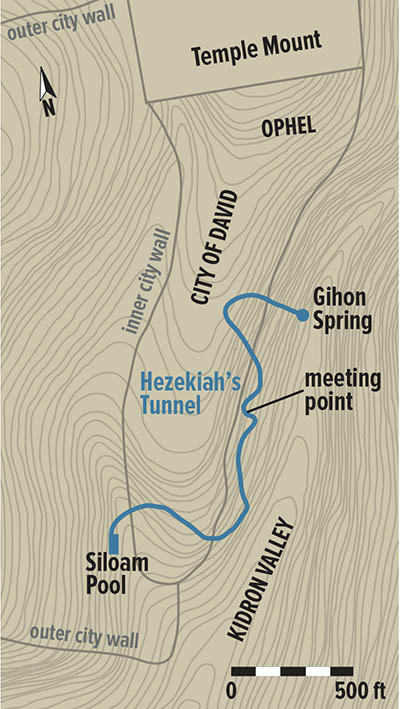
The Tomb of King David is another example of a misplaced structure in Jerusalem.
The Ancient Worship Site
In December 2011 Israeli archaeologist Dr. Eli Shukron unearthed a site beneath the City of David. This place is approximately thirty feet of the Gihon Spring. This is important because of the association of the Gihon Spring with the Temple of God. Please note how this archaeological site is carved into the bedrock of the City of David.
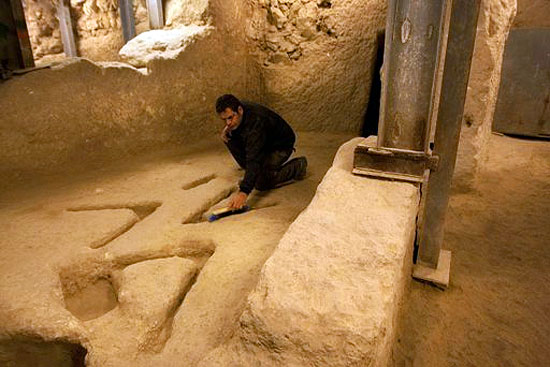
Some have expressed the idea that this was where Melchizedek, king of Salem (later known as Jerusalem) and priest of God Most High, met Abram. (Genesis 14:18-20) It is no stretch of the imagination that Melchizedek may have worshipped the Lord in this very spot.
In this site was found a natural stone pillar much like the one Jacob erected at Bethel. Because the pillar of Jacob has never been found, it is possible that this is the very stone. The pillar had been placed securely in a base of twelve stones, presumably representing the Twelve Tribes of Israel. Dr. Shukron placed a locked steel box over the pillar to protect it since this was not just a random rock found at this ancient worship site.
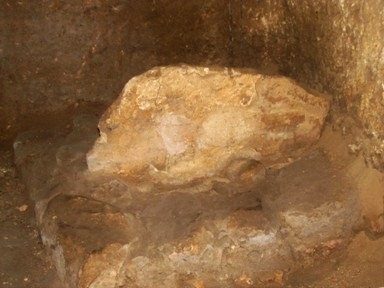
Adjacent to this pillar is an olive press for making olive oil. This press is small and was probably used for sacred purposes, unlike larger “commercial” olive presses. I believe this olive press was only for the purpose of making oil to anoint the pillar.
The archaeologists are convinced that the pillar is of Hebrew origin, and not from the pagan Jebusites who lived here before King David conquered the city.
When Jacob fled his home in Beersheba, he slept in or near a town named Luz. That night he had a dream of angels ascending and descending a ladder or stairway from Heaven. Jacob determined that this place was the House of God and named it Beth El. Jacob took the stone that he had used as a pillow and made it an upright pillar. He sanctified the pillar by anointing it with oil.
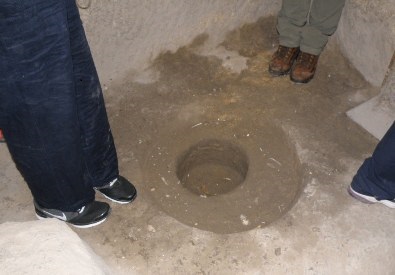
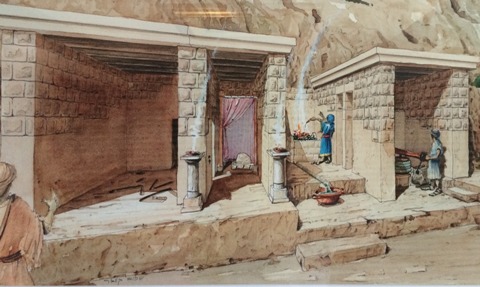
In order to confirm whether or not the rock pillar found in the City of David excavation might be the same as that erected by Jacob, I have tried to show through Scripture that Bethel and the City of David/Jerusalem are really the same place. But it will not work. In the list of cities given to the Tribe of Benjamin in the Book of Joshua, both Bethel and Jerusalem are found, so it appears they cannot be the same place.
“Now the cities of the tribe of the children of Benjamin according to their families were Jericho, and Bethhoglah, and the valley of Keziz, And Betharabah, and Zemaraim, and Bethel, . . . And Zelah, Eleph, and Jebusi, which is Jerusalem . . .” – Joshua 18:21-28
Even though Bethel and Jerusalem are two separate locations, that does not totally eliminate the rock pillar found in the special worship site from being the same rock pillar that Jacob erected. Bethel became the center of worship of a Golden Calf set up by Jereboam.(First Kings 12:28-29) It is possible that the Pillar of Jacob was rescued from this pagan site and moved to Jerusalem. The Prophet Amos foretold that "Bethel shall come to nought." (Amos 5:4-5) For this reason the pillar may have been moved the few miles between the two cities.
Scripture gives us one more indication of the importance of this site. When King David was dying, he instructed that Solomon be taken down to the Gihon Spring to be anointed king. In addition to the recently discovered ancient worship site, apparently the Tabernacle erected by King David was there also. Zadok the priest took a horn of oil from the Tabernacle to anoint Solomon king of Israel. (First Kings 1:32-40)
The ancient worship site and the Gihon Spring are in close proximity; thirty feet. It appears that the Tabernacle housing the Ark of the Covenant was also near this holy place. How appropriate was it that Solomon should be anointed king at this very place.
Why This Worship Site is Underground
Josephus, one of our best historical sources of information about Jerusalem, says that because of the size of the threshing floor of Ornan the Jebusite, Solomon built a wall to the east which ultimately resulted in “a large plain” or plaza. (Flavius Josephus, Wars of the Jews, Book V, Chapter 5, Paragraph 1) Later, Josephus describes the wall as being compassed about by a deep valley. (Flavius Josephus, Antiquities of the Jews, Book XV, Chapter 11 Paragraph 3) He also reported that the eastern cloisters were “situated in a deep valley.” (ibid. Book XX, Chapter 9, Paragraph 7)
The Josippon, a later Jewish history, states that the eastern foundation wall of the Temple came to within a cubit, or about eighteen inches, of the Brook Kidron. Josephus said that the Temple walls were so high that you got dizzy looking down. (ibid. Book XV, Chapter 11 Paragraph 5)
Nehemiah seems to confirm this extended eastern wall. He walked up the bed of the Brook Kidron to inspect the wall, which must have been right beside the brook, confirming the statements of Josephus and the Josippon. (Nehemiah 2:15) Three times in the next chapter, Nehemiah refers to the “tower which lieth out.” (Nehemiah 3:25-27) There was a tower, or wall, on the east side of Jerusalem which extended beyond the other city walls.
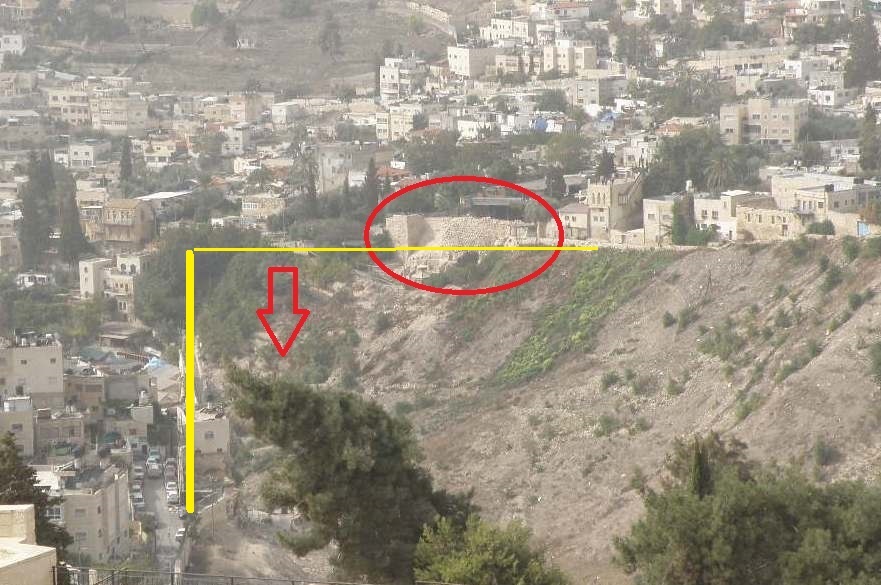
The photograph above was taken from the Mount of Olives. On the left is the Kidron valley, now filled in with the rubble of destruction and centuries of erosion and dust storms. Circled on top of the hill is the “stepped stone structure,” thought to be an ancient retaining wall. The building to the right of the circle is the City of David Museum. The arrow points to the location of the worship site found underground. The Gihon Spring is adjacent to this area.
Visualize a very high wall (vertical yellow line), a wall so high that you got dizzy just looking down over it, adjacent to the Kidron valley and imagine how much fill would be required to bring the ground up to the level of the City of David (horizontal yellow line). This was probably the location of the “tower which lieth out.” If you picture this in your mind, it is easy to see that the worship site was buried. Dr. Shukron reports that it was carefully buried. It was filled with layers of dirt and gravel. And again, how appropriate was it that Solomon, having been anointed king in this very location, should have carefully covered this holy place to erect the Temple of God above it in the City of David. Because it was underground, it escaped any notice of the Babylonian or Roman soldiers who were told to destroy the Temple and the city.
As described in Second Samuel 5:9, King David used the method of building a wall and filling in the space between the wall and the hill it encompassed with dirt and rubble. That is the meaning, according to Gesenius, of the word “Millo.” By building the Temple wall so far to the east and by filling in the space between the wall and the City of David, the area available for the Temple was greatly expanded. Remember, the City of David was originally only about twelve acres in size. This wall would have caused any structures on the east side of the hill of the City of David to be buried. This would include the fortifications around the Gihon Spring and the special site where God was worshipped .
This explains why in 1995 Ronny Reich and Eli Shukron found the Spring House, a fortification of the Gihon Spring, underground. It was buried with the fill for the Temple plaza.
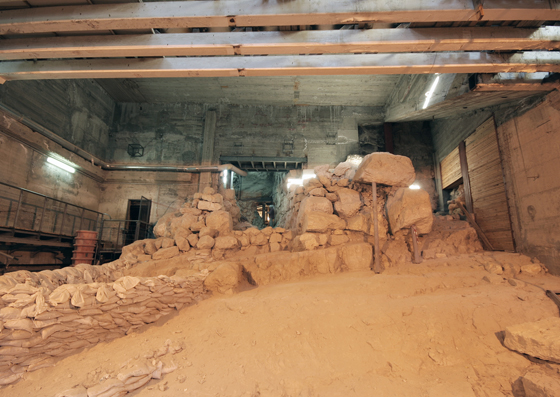

This also explains why Dr. Shukron found the worship site buried on the east side of the City of David. Dr. Shukron reports that the room had been carefully filled. This was done purposefully to protect this special place. The fill is not the detritus of the ages. The archaeologists believe it was filled for support so that a defensive wall could be built above it. I believe it was filled for support of the Temple plaza located above it.
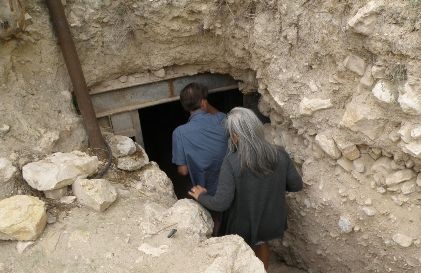
When I first realized the importance of this archaeological site, it troubled me that it was underground. I did not, and do not, think that a place sacred to the Lord would be underground. But when the Lord directed the placement of this sacred site, it was not underground!
The House of God Symbols
Also, within this special place uncovered by Dr. Shukron are symbols, several feet wide, carved or engraved deeply in the bedrock floor of the site. These symbols have mystified archaeologists since they were discovered.
When the markings were discovered, the Ir David Foundation, operators of the City of David Museum, asked for the public to give suggestions as to what they meant. The foundation received over 20,000 responses; some serious, others whimsical, others still were ridiculous (e.g. – foot prints of King Solomon’s pet dinosaur).
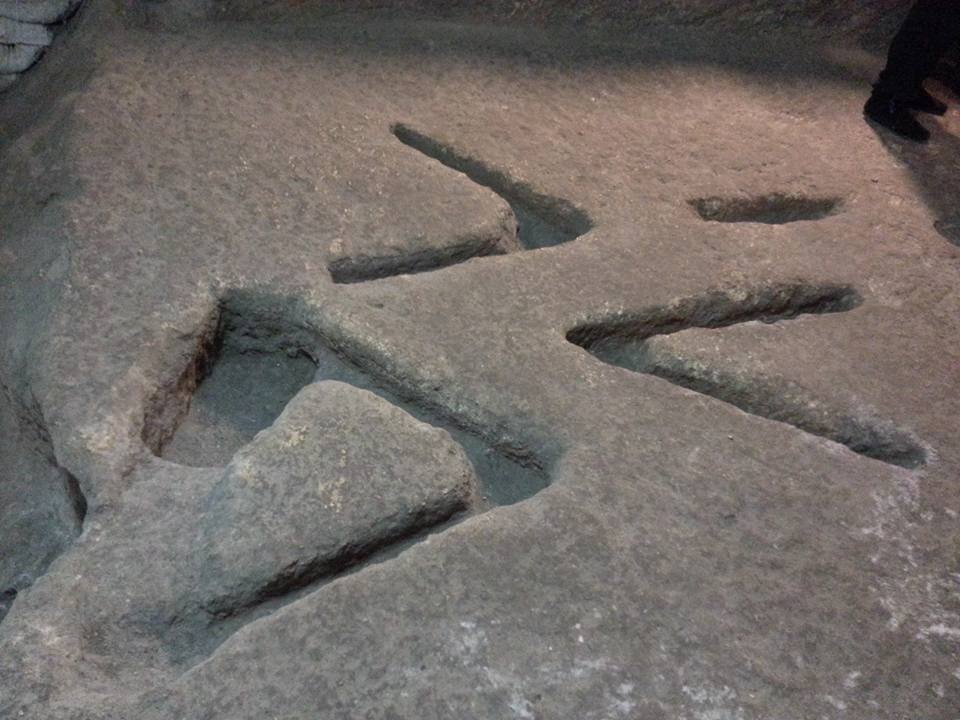
My wife and I were blessed to be able to visit this very special archaeological site in 2015. Upon returning home and studying the photographs I had taken, I became convinced that the “mysterious markings” in the bedrock floor of the site were, in fact, ancient Hebrew letters.
Below are two examples of the Hebrew letter “Beit.” The left beit is from the time of Moses. The one of the right is from the inscription found in Hezekiah’s Tunnel, which was used to channel the water from the Gihon Spring. The tunnel inscription is mere feet from the special archaeological site.
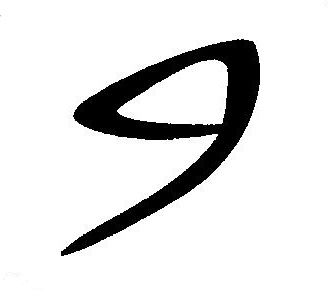
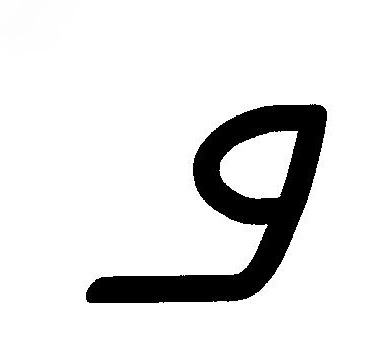
Here is the Paleo-Hebrew beit, rotated ninety degrees, compared with the letter found carved in the floor.
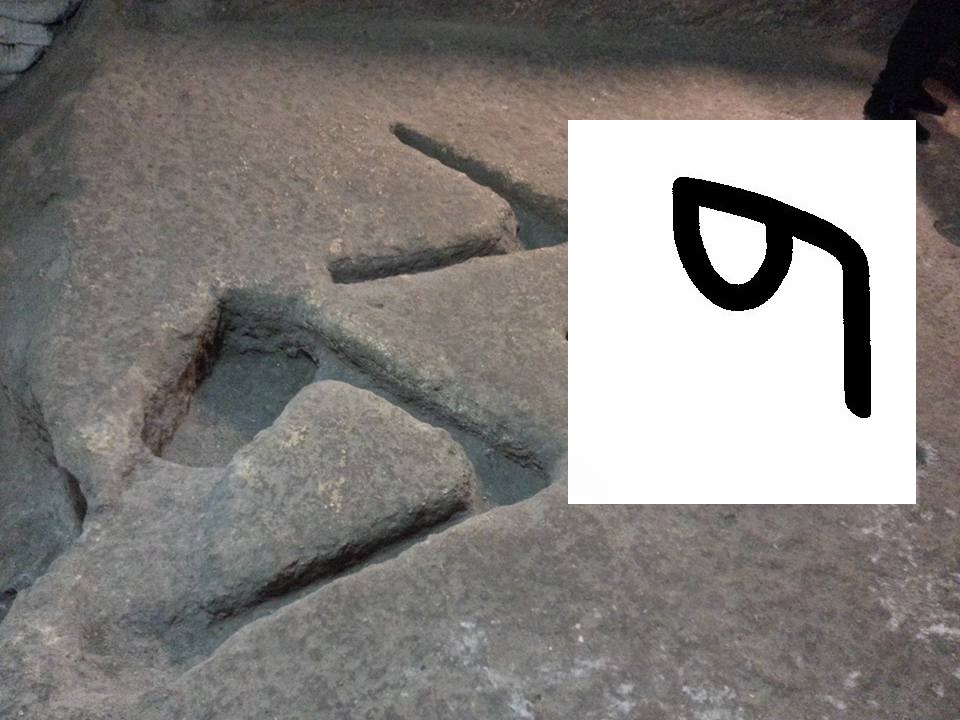
I was convinced that this “symbol” is the letter beit, which in Hebrew means “house.”
The next group of “symbols” is more difficult. I believe that together they represent the Hebrew letter “yod,” which corresponds to our English letter “J.” Here are some examples of Paleo-Hebrew yods. The yod on the left is from early Hebrew writings. The one in the center again is from Hezekiah’s Tunnel. On the right is the Nordic rune (letter) corresponding to our “J.” I give this as an example of another ancient alphabet. I believe that all alphabets are derived from Hebrew, which I believe to be the original alphabet and language.
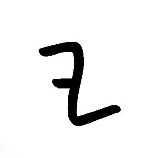

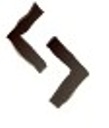
The Nordic rune appears to simply be a reversed image of the Paleo-Hebrew yod.
Here is the Paleo-Hebrew yod, inverted one-hundred, eighty degrees, compared with the letter found carved in the floor.
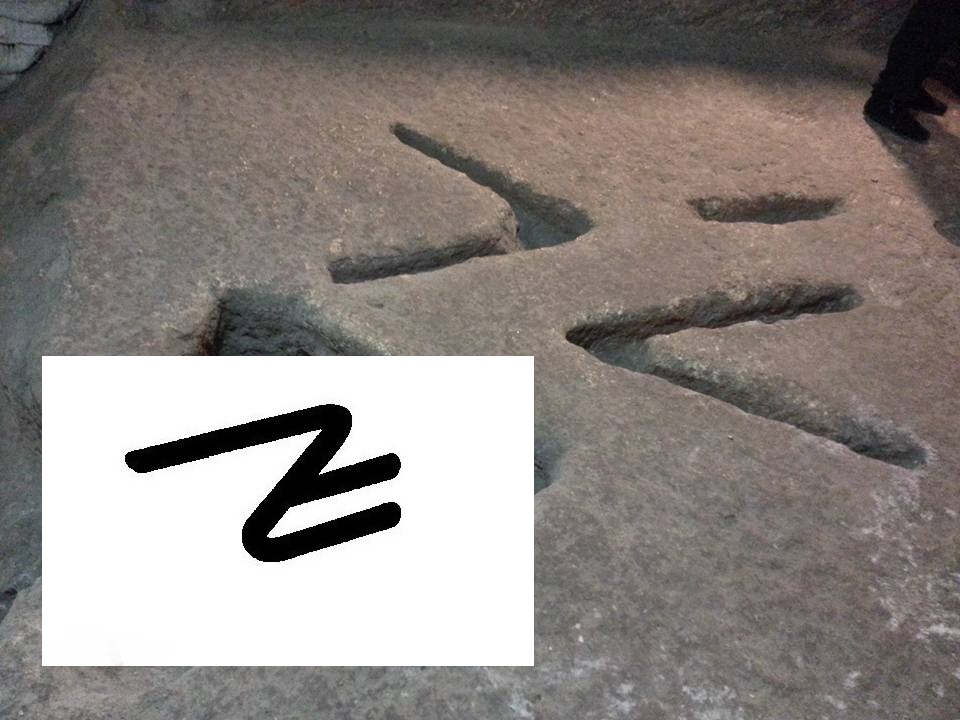
The Hebrew yod is the first letter in the name of God, JHWH, translated as LORD in the King James Version. The Lord’s name is called “Jah” in Psalm 68:4 and begins with a yod. When we say “Hallelujah” we are saying “Praise God.”
In Hebrew, beit means “house.” The yod is the first letter of the name of God, Jah. The Beit Yod together say, in my opinion, House of God.
My opinion on the markings was later confirmed as correct by Dr. William Welty, who specializes in ancient languages and has translated Hebrew and Greek texts for the International Standard Version (ISV) of the Bible.
As much as 4,000 years ago, this sacred place of worship was cut out of the bedrock of the City of David and in a location specified, I believe, by the Lord. The Lord knew that at a future time this place of worship, marked “House of God,” would be covered when the City of David was expanded for the building of the Temple. I believe the Lord was holding this sacred place “in readiness” for a future generation. I strongly suspect that He had this generation in mind.
The archaeological site, this place of worship, discovered by Dr. Shukron includes symbols of the “Godhead” or “Trinity.”
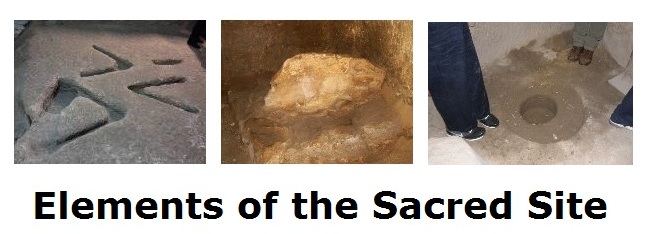
I believe this special place with the ancient stone pillar, the olive press and Hebrew letters marking it as the House of God is indeed a holy place. I believe it is a sacred place, hidden purposefully to be a confirmation of holy ground in a future time. I believe it marks the location of the House of God known as the Temple. I believe the Temple was built above this precious and holy site, and above the adjacent Gihon Spring.
It initially bothered me that this fantastic discovery did not receive any apparent notice. Part of the reason, I suspect, is the inertia of tradition. The traditional Temple Mount has been thought to be the location of the Temple for such a long time. When I showed Dr. Shukron the meaning of the letters engraved in stone, he said that it was interesting. He and other archaeologists may have a suspicion that the traditional Temple Mount is not, in fact, the location of the Temple, but to so state would cause them and their work to be ignored by the “establishment archaeologists.” Until the traditional Temple Mount is not worshipped, it will be difficult to overcome the inertia.
Another reason for the lack of notice may be from the Lord Himself. The Lord said that He would choose the place. The Lord revealed this place to David and Solomon. (First Kings 8:29) And having identified the place for His name, the place is holy unto Him.
Perhaps the Lord is not ready for His sacred site to become known. Perhaps the Lord does not want all of the folderol and commotion that is occurring at the traditional Temple Mount to take place at a site He considers sacred and holy.
I present this astounding discovery because there are Brothers and Sisters in Christ who will be amazed and blessed just as I was. The Lord blessed me with this discovery, and I pray it will be a blessing to those who can receive it.
One thing is certain. When the Lord chooses, at the appropriate time, this sacred site denoted as the House of God, will become known, and perhaps preparation for the building of the Temple will begin. If I am correct, the Temple site will be in the City of David, south of the traditional Temple Mount. If I am wrong, the Lord will confirm the location wherever He determines. May His will be done.
I personally feel very sure that the archaeological site found by Dr. Eli Shukron is a very special, holy, sacred place. I would not be surprised if Abraham and Melchizedek worshipped there. Scripture tells us that Solomon was anointed king in this location. I believe it is the location of the House of God and it marks the location, that is the City of David, of the original Temple of Solomon. What a privilege and blessing to have stood in that very place!